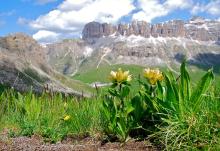An image of the impressive Gentiana punctata captured on the Bindelweig in the Dolomites of Northern Italy. A true alpine, but grows to 60cms in ideal conditions.
Comments
Re: Gentiana punctata
About these most gorgeous and awesome photos you take, Cliff (the ones with the mountain views in the background):
---- Are you focusing on the foreground plant, and using the smallest possible f/stop to keep the scenery in fair focus? Or does that not seem to matter?
---- Are these photos first take with a more panoramic view, so the subject is not really as close to the camera lens as it would seem, and then cropped significantly so that focus of foreground and background is less divergent?
(Actually, now that I think about it, with the camera at ground level I am not sure you even could take any steps back for a more panoramic view (?))
Re: Gentiana punctata
Hi Rick,
You are very kind, your comments are much appreciated.
I don't wish to sound trite, but I find it difficult to explain how I obtain these shots. It must be a conscious decision to fling myself onto the hard earth and focus as closely as possible on the nearest plant, but everything else is usually down to the DSLR.
Most images are captured in auto mode, always without tripod and usually with my aged body contorted into unhealthy positions.
I have always 'tried' to get as many 'plant and landscape' shots as possible but I can't cite a fathomable technique.
The image in question was cropped a little on the left and at the bottom, highlights were altered a tad to enhance the sky and I think that was all. See the original below.
Sorry I can't be of more assistance ... I get asked this question at nearly every lecture that I give, I shall have to concoct a technical answer. :D
Re: Gentiana punctata
Actually, Cliff, I can interpolate my answers from your reply. Thanks. I am well versed with the old film camera methods, and I know how difficult (if not impossible) it would be to render such photos on film. But not ever having the opportunity to fiddle with similar situations with a digital format yet, I am very curious and glad to know how the digital world has once again made yet another task relatively obtainable (notwithstanding the body contortions). ;)



A beautiful photo, Cliff!